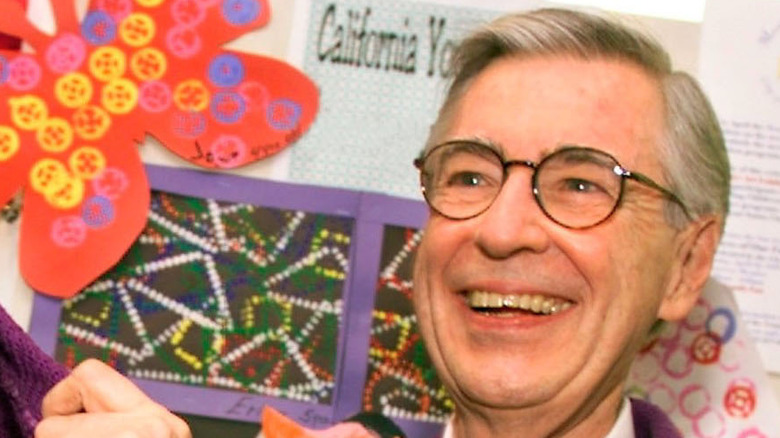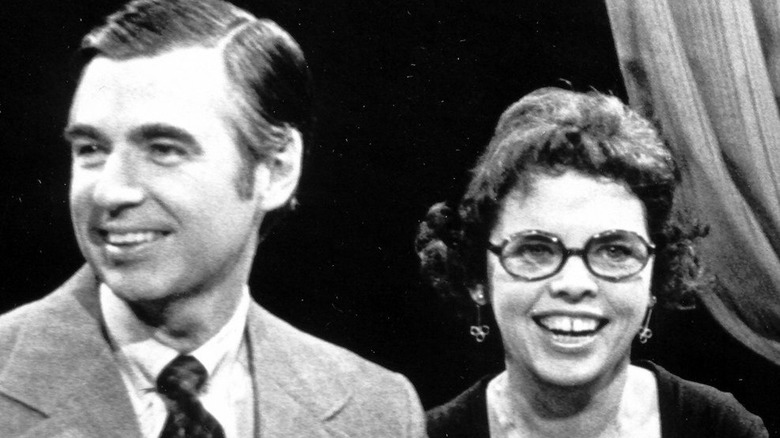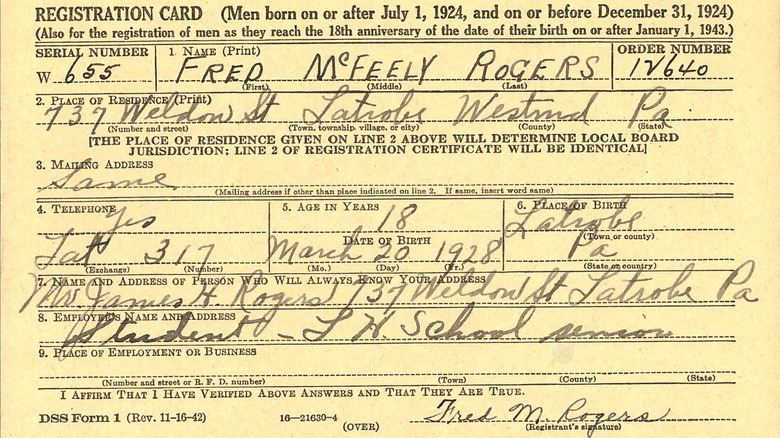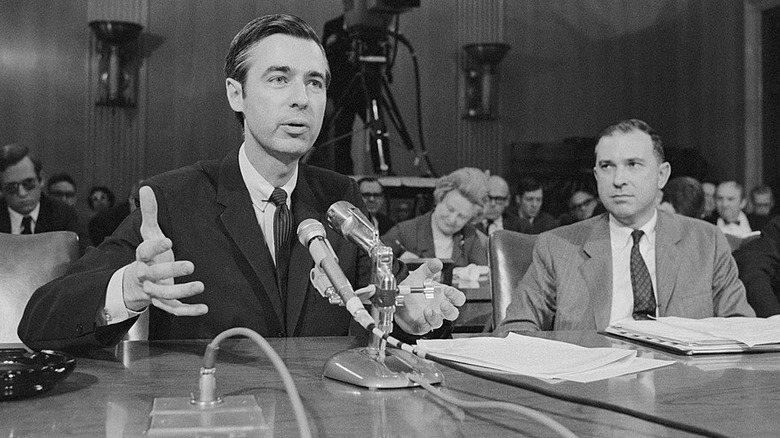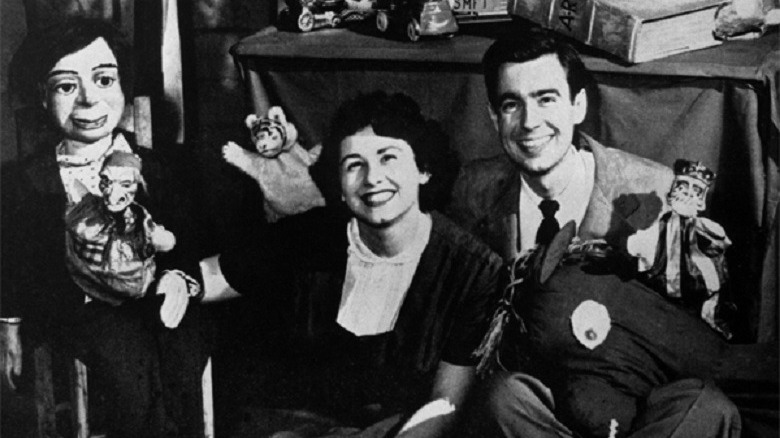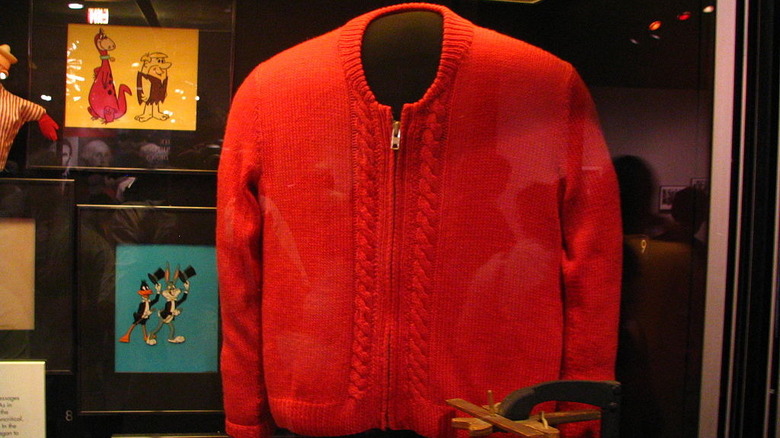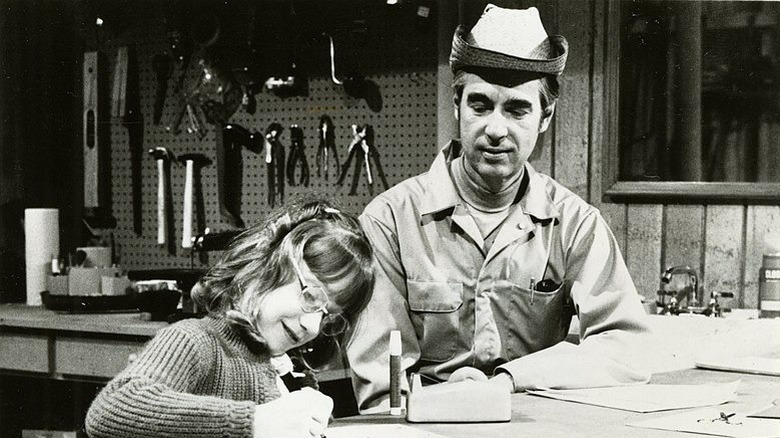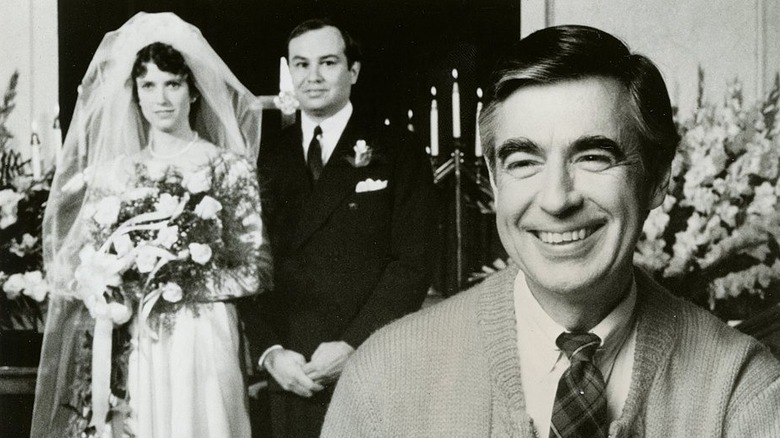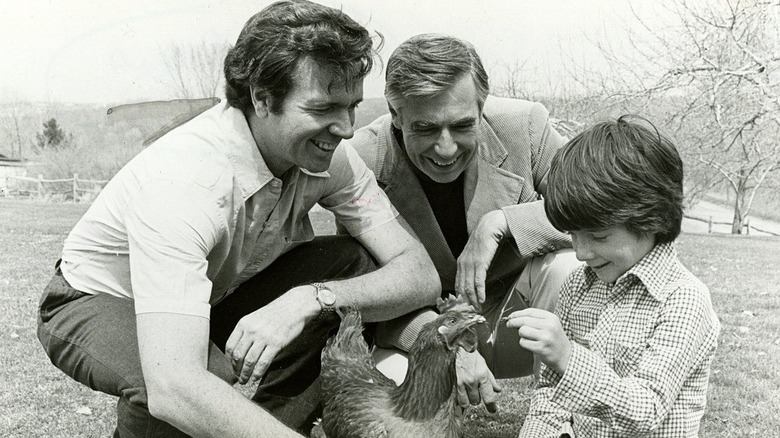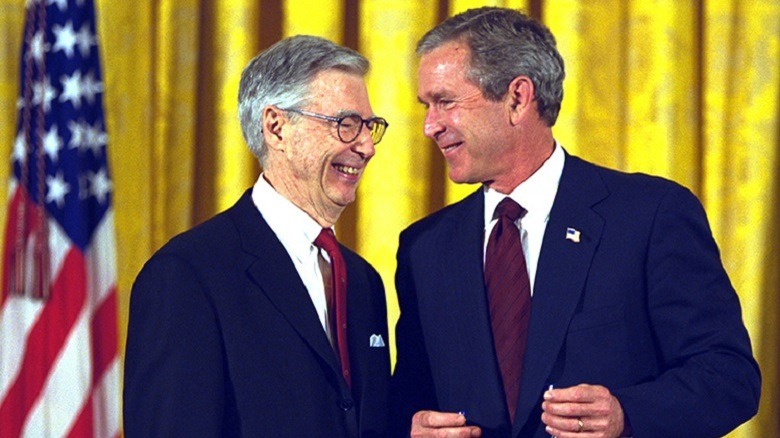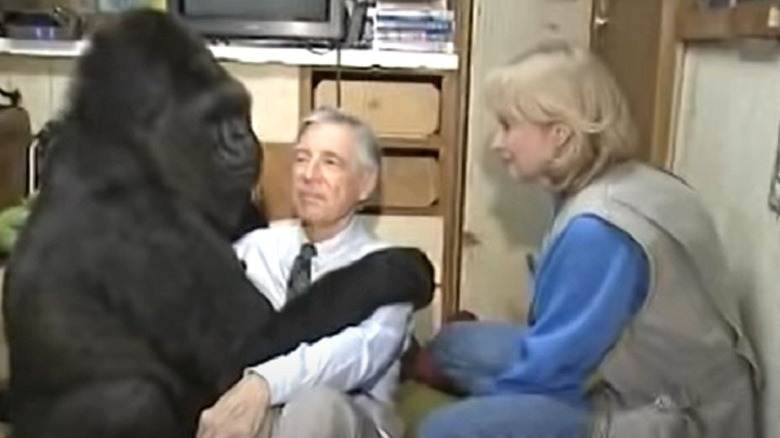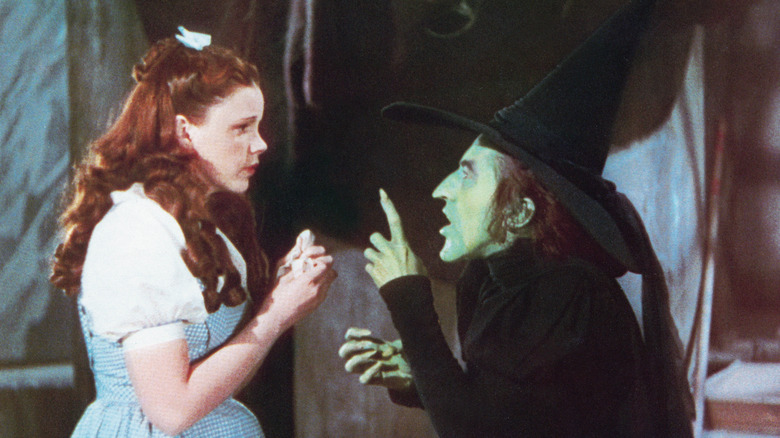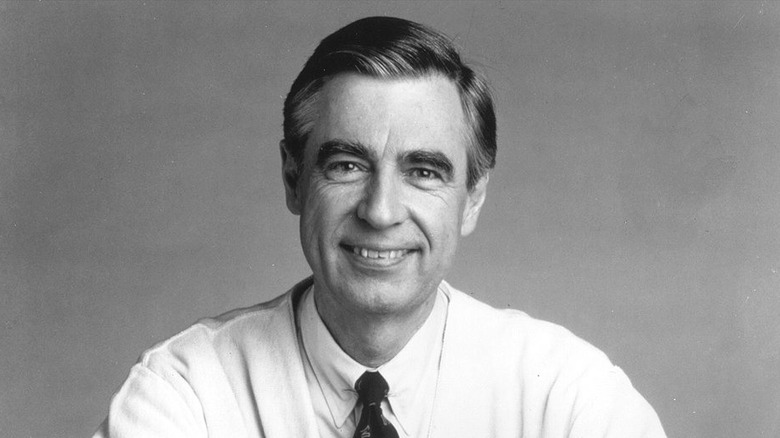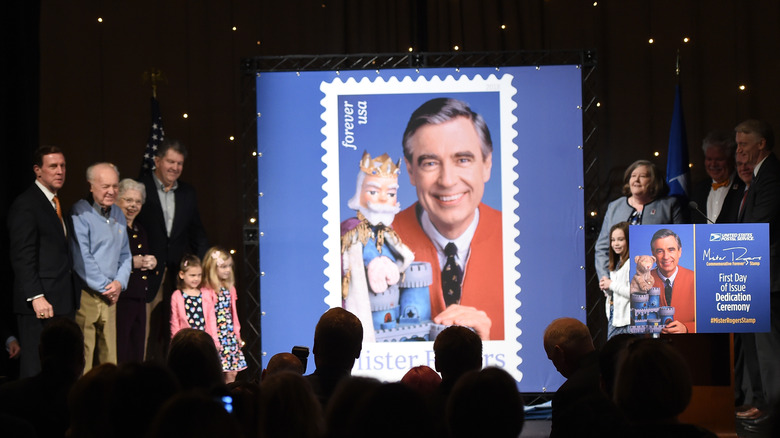The Untold Truth Of Mr. Rogers
We may receive a commission on purchases made from links.
It isn't always easy to wake up to a beautiful day in the neighborhood. Enter Fred Rogers, the creator and endearing host of "Mr. Rogers' Neighborhood," which aired on public television for an amazing 31 seasons and brought happiness into many children's lives. In his Neighborhood of Make-Believe, everyday was a beautiful day.
Although his childhood in Latrobe, Pennsylvania was fraught with shyness, health and weight problems, Rogers managed to overcome his troubles to later help children through their own lives and issues of the day with empathy. And he did it beautifully.
Throughout his career, the soft-spoken Mr. Rogers covered an array of topics, including world affairs, in a way that kids could understand. No wonder he received numerous awards throughout his career. Everybody loved him, even comedians like Eddie Murphy, whose parody, "Mr. Robinson's Neighborhood," was a hit on Saturday Night Live. There are no hidden secrets about Mr. Rogers, although there are plenty of interesting facts about the man. He didn't drink, or smoke. He was a vegetarian. He loved to cook. He remained close to his mother, who knitted the signature cardigans he wore on his show. He was an ordained minister. And there's more. Read on for the untold truth of Mr. Rogers.
Fred Rogers left an Ivy League School to major in music
Fred Rogers was deeply affected by classmates who teased him in grade school. But he battled it in the most positive way possible, by using his imagination and playing the family piano. When he wanted his very own piano, at the age of 10, his grandmother purchased a $3,000 Steinway grand for him. Rogers kept it for the rest of his life. And when he got to high school, he found the confidence he was looking for and was even elected student council president during his senior year. Upon graduation, he enrolled at Dartmouth College, an Ivy League school in New Hampshire.
However, Rogers wanted a better music program than Dartmouth could offer. Accordingly, he transferred to Rollins College in Florida and majored in music composition and theory. He also met his future wife, Joanne Byrd (pictured), who remembered how Rogers "sat right down and started playing some pop stuff. And we were so impressed, because none of us could do that." After graduating in 1951, Rogers used his musical talent to get a job in television. But he never forgot Joanne, proposing to her in a letter after leaving Florida.
Later, during the entire run of "Mr. Rogers' Neighborhood," Rogers would compose all the songs for the show. "He wrote over 200 songs," said his nephew Daniel Crozier.
Mr. Rogers was a minister, not a sniper or Navy Seal
Fame nearly always begets rumors. The worst one about Fred Rogers was that he served in the Vietnam War as an abusive and rebellious sniper, covered with tattoos and "flipping off television cameras" as he went (via History). Thankfully, that simply isn't true. Although he dutifully registered for the draft in 1948, Rogers was never called to serve due to an unknown health issue. A story that he was a Navy Seal also is false, seeing as when the seals debuted in 1962, Rogers was in Canada filming his fledgling show.
In fact, the naughtiest thing he ever did, if you can even call it that, was take his morning swim in his birthday suit to maintain his 143 pounds — which he said correlated to "I" (one letter) "love" (four letters) "you" (three letters).
It is true that Rogers studied ministry at the Pittsburgh Theological Seminary while working at WQED, a public television station, and making weekly trips to New York for a live show. Upon graduating, the newly ordained Presbyterian minister decided that his ministry should be to "serve children through television." And when the Pittsburgh Presbytery declined to offer help, Rogers remained steadfast and raised funding for his project himself.
The beginnings of Mr. Rogers' Neighborhood
Fred Rogers' longtime friend, John Sinclair, once recalled a time that Fred and Joanne Rogers came to his party. Fred disappeared. Joanne told Sinclair to "Find your children, he's probably there." Indeed, Rogers was off playing the Sinclair's children, making goofy faces and having a good time. "I've always loved children more than adults," he explained to Sinclair. And he did not, according to Parade, care for "the shallow, demeaning" shows for kids that he saw on television. Rogers wanted something better.
In his book, "The Good Neighbor: The Life and Work of Fred Rogers," author Maxwell King submits that Rogers' own tumultuous childhood inspired him to start his own show just for children. Fellow children's show host Gabby Hayes advised him to talk as though he was speaking to just one child, so that's what he did. And instead of lecturing his audience, Rogers was known to advise his young viewers to listen to their "favorite grown-ups" in a way that validated the life facts they needed. Later, in 1969, Rogers' speech before the Senate Subcommittee on Communications about the importance of quality children's television moved the audience so much that the Public Broadcasting System (PBS) saw a jump in federal funding.
Mr. Rogers' show first aired in Canada
According to the Christian Science Monitor, by the late 1950s Fred Rogers was working as a puppeteer on "The Children's Corner" in Pittsburgh. He was approached by Fred Rainsberry of the Canadian Broadcasting System (CBC) to host a show in Canada called "Misterogers." The show was only 15 minutes, but Rogers would be directly on camera instead of behind the scenes. Rogers agreed, and moved his wife and two children to Toronto for the show in 1963.
The Neighborhood Archive says that Rogers' first year in Canada was spent planning the show. All of the now-familiar elements were there: Rogers' trademark cardigan, his music and puppets, and his signature trolley rolling through the Neighborhood of Make-Believe. The show was, in essence, "an early Canadian prototype" for the future "Mr. Rogers' Neighborhood." In 1966, however, the Rogers' decided to return to America and expand "Misterogers" to a half-hour show. PBS picked it up in 1970, and the rest is history.
The truth about that cardigan and those sneakers
You know the drill. On each episode of "Mr. Rogers' Neighborhood," Mr. Rogers sails through the door and sings "It's a Beautiful Day in the Neighborhood" while exchanging his jacket for a colorful sweater out of his closet and changing from street shoes to tennis shoes. Every. Single. Episode. Why would he do this? Rewire's Christine Jackson offers that the show typically aired late in the afternoon when parents were getting off work. Rogers wanted to express the familiarity of changing into more casual clothing, i.e. "casual time," at the end of the day. Then there were the sweaters, which Rogers explained in a 1999 interview with the Television Academy Foundation were knitted by his mother, one every month.
Notable too, says blogger Nick Riccardo, is that Rogers originally had buttons on his sweaters, but because they took too long to button, he switched to zippers. One of them hangs in the Smithsonian Institute today. As for his shoes, Rogers favored navy blue Sperry Topsiders and Converse sneakers. Of course these were part of the sense of relaxation Rogers wanted to convey to his viewers, but there was another reason too: Parade says that Rogers' dress shoes could sound noisy on the set's floors, and that sneakers made it much quieter as he moved around.
Mr. Rogers considered his viewers his friends
Clearly, "Mr. Rogers' Neighborhood" was more than just a show for children. While earning his ministerial degree, Rogers also studied child development. And throughout the run of his show, he firmly refused to permit commercials that marketed to children. His young fans came first, always. "Anyone who does anything to help a child in his life," he once said, "is a hero to me."
Later, Rogers' now-grown fans remained inspired by him. Tom Junod, whose 1998 article about Rogers in Esquire was the inspiration for the 2019 film "A Beautiful Day in the Neighborhood," applauded the host for successfully finding a way to "speak to children as respectfully as he spoke to adults and to speak to adults as simply as he spoke to children."
When staffer Hedda Sharapan wrote a manual for physicians about how to speak with children, Rogers reminded, her, "You were a child once too." It was important to him that adults never forget that. Another fan, Deborah Farmer Kris, wrote that Rogers constantly reminded grown-ups that children needed to learn that feelings like sadness would not last forever.
Mr. Rogers explained concerns to children with understanding and dignity
It was important to Fred Rogers to cover some mighty scary topics on his show, from death and divorce to wars and racial issues. Once, for instance, he found a dead goldfish in the aquarium on the set of his show. Rather than hide it, Rogers used the fish to explain and alleviate fears about death. Often, he furthered his teachings through the songs he sang. But he also offered simple strategies for parents, to help them help their children as they grew.
Giving children "everything that we possibly can to help them grow in healthy ways" was of utmost importance to Mr. Rogers, who was occasionally called to action above and beyond his show. Take young Beth Usher, for instance, who was suffering upwards of 100 seizures daily due to a brain issue. Watching "Mr. Rogers' Neighborhood" miraculously alleviated her symptoms. With brain surgery looming, Usher's mother contacted the studio asking for a signed photo. Rogers called Beth that very night, chatting with her on the phone in his puppet voices and sending her a box of memorabilia as she headed to the hospital. And when she went into a coma after surgery, Rogers even visited her in the hospital and left his puppets for her. She woke up a short time later, and the two remained friends for life.
Mr. Rogers personally answered all of his fan mail
What does a celebrity do when he receives thousands of pieces of fan mail a month? If he's Mr. Rogers, he responds to every single one. Fred rogers never threw one letter away. And the letters he responded with weren't just form letters; they were hand-written by Rogers himself and "deeply personal in nature." Rogers' assistant, Heather Arnet, carefully cataloged each letter he received, most of which expressed real-life issues and concerns.
Some of the letters Rogers received were more than the garden variety of children's concerns. Take six-year-old Amy Melder, a young Christian who decided to write Mr. Rogers so she could "make sure he knew he was going to heaven." Of course Rogers wrote back, thanking Melder for the scripture she wrote and letting her know that "Jesus is important to me, too."
Other of Rogers' fan letters were published in "Dear Mr. Rogers, Does It Ever Rain in Your Neighborhood" in 1996. Fred Rogers Productions continues to accept fan mail today.
Fred Rogers received an amazing amount of awards
Children were certainly not the only ones who took note of Mr. Rogers and his neighborhood. Beginning in 1969 with a Peabody Award, Rogers would be nominated for 66 awards throughout his career. The first of four Daytime Emmy Awards was presented to him in 1980. He also won the CINE Golden Eagle award in 1986 and 1987. Ten years later he was given the Lifetime Achievement Award by the National Academy of Television Arts & Sciences, and his acceptance speech was indeed memorable as he humbly asked everyone to take ten seconds to remember who helped them get where they were.
More awards would come, included being inducted into the Television Hall of Fame in 1999, and being the honorary first recipient of the annual Corporation for Public Broadcasting Fred Rogers Award in 2001. One of his most memorable honors was in 2002, when President George W. Bush personally awarded him the Presidential Medal of Freedom for his "contributions to children's education." He was also given 40 honorary degrees.
And, just after his death in 2003, the U.S. House of Representatives unanimously voted for "Resolution 111," which honored Rogers for efforts on behalf of children everywhere, as well as "his steadfast commitment to demonstrating the power of compassion, and his dedication to spreading kindness through example."
One of Mr. Rogers' biggest fans was Koko the gorilla
Remember Koko, the amazing gorilla who was taught sign language beginning in 1971 and challenged the way we think about animals? Long before she passed away in 2018, Koko visited with a number of celebrities including Leonardo DiCaprio, William Shatner, Robin Williams, and, of course, Mr. Rogers. And their visit in 1998 was definitely a moment to remember as the 127 kg (nearly 280 pounds) ape wrapped her big arms around Rogers in a loving embrace.
Although only portions of Rogers' time with Koko can be seen on the internet, she was a big fan of his show. When he walked into the room not only did Koko recognize him, but she also hugged him, inspected his cufflinks closely and told him she loved him. She also unzipped his cardigan, and loved the gift he brought for her: a stuffed Daniel Tiger, one of the puppet characters who appeared regularly on "Mr. Rogers' Neighborhood." The most memorable moment of their visit? "She took my shoes off," Rogers said in his 1999 interview with Tom Junod.
Celebrity guests and future stars appeared on Mr. Rogers' Neighborhood
Here's an interesting fact: Fred Rogers liked a good zombie movie. He described "Dawn of the Dead" and "Night of the Living Dead" as "a lot of fun," perhaps because they were made by filmmaker George Romero, whom Rogers employed on "Mr. Rogers' Neighborhood." Another notable employee? Actor Michael Keaton, who was working as a stage hand when he played a practical joke on Rogers by putting a blow-up doll in his closet on the set. Rogers was unfazed, dancing across the set with the doll before putting it back where he found it.
Then there were the many celebrity guests on "Mr. Rogers' Neighborhood." Parade lists chef Julia Child in 1974, singer Tony Bennett in 1975, and cello player Yo-Yo Ma in 1990. Actress Margaret Hamilton, who starred as the Wicked Witch of the West in 1939's "Wizard of Oz" was also a guest. Hamilton and Rogers wanted to relay to children that there were nice witches too, and that Hamilton played a character and wasn't scary at all.
The end of Mr. Rogers' Neighborhood
In 2000, after 33 years of "Mr. Rogers' Neighborhood" (the exception being a hiatus between 1976 and 1979), Fred Rogers decided to retire. At the age of 72, he was slowing down and had already reduced the number of episodes of his show to around 15 per year. The last of over 900 episodes was taped in December 2000 and aired in August 2001. The Washington Post called it "one of the most striking final episodes of a beloved television series in recent years." There was no publicity about it, no media on set, no character synopsis, just Mr. Rogers hanging up his cardigan for the last time.
A year later, Mr. Rogers was back on television, but only for a moment. On the first anniversary of the horrific 9/11 attack in 2002, Rogers appeared in a brief video clip on public TV channel GBH. There was no mention of the attack, but he did talk around it. " I'm so grateful to you for helping the children in your life to know that you'll do everything that you can to keep them safe," he told viewers.
Two months later, Rogers was diagnosed with stomach cancer, but he put off surgery until he served as the Grand Marshal of the New Year's Day Rose Parade. Still the surgery was unsuccessful and, with Joanne at his side, Rogers passed away at his home in Pittsburgh in February 2003.
The legacy of Mr. Rogers
In 2019, John Sinclair remembered a time that Fred Rogers had admired his cuff links. Sinclair later gifted them to his friend for Rogers' 50th wedding anniversary. Just before he died, Rogers returned the cuff links to Sinclair with a note reading, "To John Sinclair, friend and cuff link collector, thank you for sharing these with me."
Even at the end of his life, Rogers left a special place in the hearts of friends and America in general. In 2004, the documentary "Fred Rogers: Still America's Favorite Neighbor" aired to the delight of fans everywhere. And in 2018, the postal service featured Rogers on a stamp. More kudos would come.
In 2019, "A Beautiful Day in the Neighborhood," starring Tom Hanks, hit theaters. Hanks said that watching "Mr. Rogers' Neighborhood" in preparation for the movie "made me think a lot about myself as a man and a father." Rolling Stone called the movie "as open-hearted as Mister Rogers," although reviewer Monica Castillo gave it only 3.5 stars.
It would be nice to believe that everyone feels like Fred Rogers did when he concluded each show by telling us, "There's no person in the whole world like you; and I like you just the way you are."
